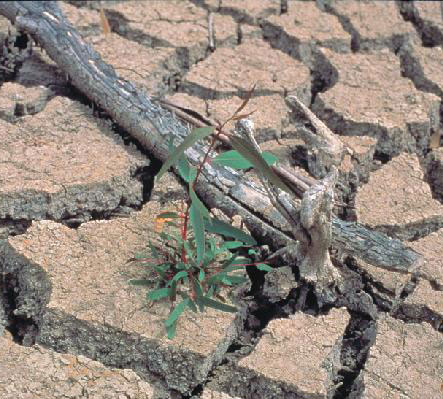Background
Drought impacts on standing waters
What happens
Permanent standing waterbodies - such as pools, wetlands and lakes - generally are fed by permanent inflow of water either from surface streams or from groundwater, with the volume being maintained by drainage or evaporation. Ephemeral or temporary standing waters, on the other hand, are fed by intermittent flows or rainfall, and the waters dry up in the absence of these sources.
Drought reduces the amount of water flowing into standing waterbodies, but does not usually reduce evaporation, so the waterbody shrinks.
As the waterbody shrinks:
- The part of the bed or channel that is normally at the edge of the water (the 'littoral zone') is left high and dry, stranding fauna such as mussels and rooted plants such as reeds.
- The concentrations of salts (measured by electrical conductivity) and suspended solids (turbidity) in the water increase, and the dissolved oxygen concentration decreased.
- Water temperatures may rise (depending on season), and the water may stratify into layers, particularly if there is very little water movement. The layers tend to have different characteristics of temperature, nutrient concentration and dissolved oxygen concentration.
- The combination of high temperatures and low oxygen levels may kill some species of fish and other fauna.
- Nutrients (especially nitrogen and phosphorus) may be released from the sediments that form the bed of the waterbody, increasing the risk of algal blooms, particularly of blue-green algae.
- In some pools, especially unshaded ones, algal blooms may occur.
- In pools with stored organic matter (such as dead leaves from streamside trees), the leaf contents will progressively leach into the water, and decay processes will use up dissolved oxygen. In Australian native trees, leaf-fall normally occurs in summer. When drought stress on the trees causes more than usual leaf fall, the dissolved organic matter in pools may be a significant hazard for the fauna.
- Resident fish populations will be competing to survive in less and less water, making them more vulnerable to their predators, including other fish and waterbirds or land-based predators.
- In pools with high densities of trapped fauna the levels of parasitism and disease, notably of fish, can rise.
There are parallels to be seen in the waterholes of arid areas.
Human effects
Human activities in the catchments and localities of standing waterbodies, now and in the past, can make a drought bite deeper into the condition of freshwater ecosystems.
However, management [link to Sustaining aquatic ecosystems through drought] can alleviate some of this, either through proactive planning and action between droughts, or by reactive responses during drought.
Desirable ecological condition for standing waters
- Live and healthy bank vegetation.
- Few or no alien species in the waterbody.
- No extra nutrients entering the waterbody, e.g. from animal dung, sediment, or other contamination.
- No predation (via fishing, netting) by humans.
- Naturally declining water-level (no removal by humans or stock).
- Occasional additions of water to the waterbody (by rain or environmental water allocation).
- Occasional water movement in the waterbody to break up stratification.
- Refuge habitats exist within and around the waterbody, and are protected against interference from humans or pests.
See downloads:
- Billabongs: refuges or fish traps?
- Progress in understanding dry rivers.
- Life in the slow lane: how a freshwater turtle comes to thrive in the outback.
- Dryland River Refugia newsletters nos. 1 (2002) and 2 (2003).
Useful references:
- Arthington et al. 2005
- Arthington, Bond, Lake, Marshall (in press)

